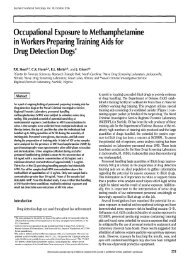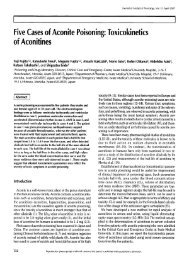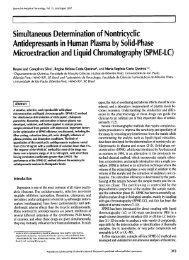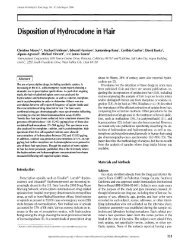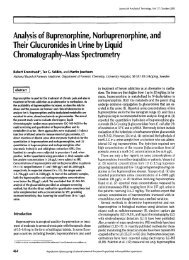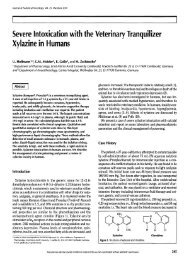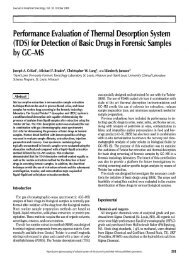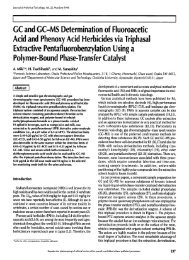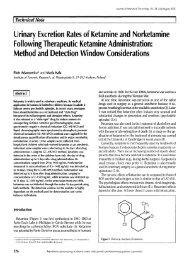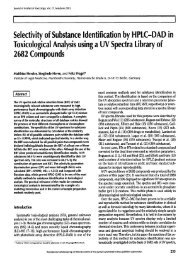Nitrite Adulteration of Workplace Urine Drug-Testing Specimens I ...
Nitrite Adulteration of Workplace Urine Drug-Testing Specimens I ...
Nitrite Adulteration of Workplace Urine Drug-Testing Specimens I ...
Create successful ePaper yourself
Turn your PDF publications into a flip-book with our unique Google optimized e-Paper software.
Journal <strong>of</strong> Analytical Toxicology, Vol. 22, March/April I998<br />
<strong>Nitrite</strong> <strong>Adulteration</strong> <strong>of</strong> <strong>Workplace</strong> <strong>Urine</strong> <strong>Drug</strong>-<strong>Testing</strong><br />
<strong>Specimens</strong> I. Sources and Associated Concentrations<br />
<strong>of</strong> <strong>Nitrite</strong> in <strong>Urine</strong> and Distinction Between Natural<br />
Sources and <strong>Adulteration</strong><br />
Francis M. Urry 1,2, Gabor Komaromy-Hiller 2, Brian Staley 2, David K. Crockett 1, Mark Kushnir 1, Gordon Nelson 1,<br />
and Richard E. Struempler 1<br />
1ARUP Laboratories, Inc., 500 Chipeta Way, Salt Lake City, Utah 84108 and 2Department <strong>of</strong> Pathology, University <strong>of</strong> Utah<br />
School <strong>of</strong> Medicine, Salt Lake City, Utah 84112<br />
Abstract<br />
The active ingredient in the commercial workplace urine<br />
drug-testing adulterant, Klear, was previously determined to be<br />
nitrite ion. <strong>Nitrite</strong> adulteration compromises the confirmation <strong>of</strong><br />
some drugs, notably the marijuana metabolite. A previously<br />
reported bisulfite step overcomes some nitrite adulteration, but it<br />
cannot do so in every case, which leaves the laboratory to report<br />
the specimen as not suitable for testing. Unlike many other<br />
adulterants, nitrite is found in normal urine at low concentrations.<br />
In order to defend a report <strong>of</strong> nitrite adulteration, it is necessary<br />
to provide evidence that the amount <strong>of</strong> nitrite in a workplace<br />
urine specimen could not arise by normal means. The objectives<br />
<strong>of</strong> this study were to identify all sources <strong>of</strong> nitrite in urine and the<br />
range <strong>of</strong> concentrations associated with these sources and to<br />
determine if nitrite adulteration can be supported based upon a<br />
quantitative result. The scientific literature was reviewed for<br />
internal and external sources <strong>of</strong> nitrite and their concentration<br />
ranges and are reported. The following specimens were obtained<br />
and nitrite concentrations measured by a spectrophotometric<br />
method: clinical specimens nitrite positive by test strip<br />
(< 15 pg/mL); specimens culture positive for nitrate-reducing<br />
microorganisms (< 36 pg/mL); specimens from patients on<br />
medications that may metabolize to nitrite (< 6 pg/mt); and<br />
drug-test specimens, both negative (< 130 pg/mL) and others that<br />
appeared to be adulterated with nitrite (range 1910-12,2])0<br />
pg/mL, mean 5910). The literature and the nitrite measurements<br />
<strong>of</strong> this study indicate a substantial difference between<br />
concentrations from natural sources compared with adulteration.<br />
A quantitative measurement <strong>of</strong> nitrite by a well-structured assay<br />
can provide scientifically valid and forensically defensible pro<strong>of</strong><br />
<strong>of</strong> adulteration with a nitrite-containing substance.<br />
Introduction<br />
The growth <strong>of</strong> employment drug testing has been accompa-<br />
nied an increase in commercial products to help the donor avoid<br />
being detected as a drug user. A current commercial product,<br />
Klear, is widely available and is represented as being able to<br />
clear all positive drug-test results. The Klear product consists <strong>of</strong><br />
two rnicrotubes <strong>of</strong> a white crystalline material, and each tube<br />
contains approximately 500 rag. When added to urine after<br />
voiding, the material readily dissolves without altering the tem-<br />
perature, and no visual change occurs in the specimen. At the<br />
laboratory, there is no obvious sign <strong>of</strong> adulteration, and there are<br />
no changes in normal values for creatinine, specific gravity, or<br />
pH. The laboratory first becomes aware <strong>of</strong> an adulterant when<br />
the specimens' initial test is positive (usually for cannabinoids)<br />
but fails to confirm by gas chromatography-mass spectrometry<br />
(GC-MS) because <strong>of</strong> a substantial reduction in the recovery <strong>of</strong><br />
the monitored ions <strong>of</strong> 11-nor-9-carboxy-A"-tetrahydrocannabinol<br />
(9-THCA) and its internal standard. Informal communications<br />
among laboratorians suggested that the active ingredient may be<br />
a form <strong>of</strong> nitrite. E1Sohly et al. (1) determined the substance to<br />
be potassium nitrite and provided evidence that nitrite leads to<br />
decomposition <strong>of</strong> the ions <strong>of</strong> 9-THCA and its internal standard.<br />
They indicated that the interference could be overcome through<br />
the use <strong>of</strong>a bisulfite step at the beginning <strong>of</strong> sample preparation<br />
for GC-MS analysis. The bisulfite step is helpful, but, in our<br />
experience, it reverses the nitrite pattern only about half the<br />
time, thus preventing the confirmation <strong>of</strong> some specimens<br />
whose initial test is positive for cannabinoids.<br />
If any specimen is determined to be adulterated by the lab-<br />
oratory, and the result can be defended scientifically and foren-<br />
sically, the Department <strong>of</strong> Transportation has authorized the<br />
laboratory to report the specimen as adulterated and has given<br />
the medical review <strong>of</strong>ficer guidance on how to proceed (2).<br />
However, unlike other adulterants such as glutaraldehyde (e.g.,<br />
UrinAid), soap (e.g., Mary Jane Super Clean 13), and bleach,<br />
nitrite at low concentrations is a constituent <strong>of</strong> normal human<br />
urine. The purposes <strong>of</strong> this study were to identify the various<br />
sources <strong>of</strong> nitrite in urine and their associated concentrations<br />
from the scientific literature and direct testing and to deter-<br />
mine if a clear distinction between adulteration and other<br />
explanations for nitrite presence can be made based on con-<br />
centration.<br />
Reproduction (photocopying) <strong>of</strong> editorial content <strong>of</strong> Ihis journal is F, rohibited without publisher's pemfission. 89
Experimental<br />
The commercial product Klear was purchased from a local<br />
merchant. The package insert directs the donor to "Add the<br />
contents <strong>of</strong> one tube <strong>of</strong> Klear to each urine sample...For large<br />
samples <strong>of</strong> more than 4 oz. use two tubes". The urine test strip<br />
Chemstrip TM was used to screen for nitrite and was obtained<br />
from Boehringer Mannheim (Indianapolis, IN).<br />
<strong>Specimens</strong> for determination <strong>of</strong> nitrite concentrations<br />
In order to determine the concentration <strong>of</strong> nitrite in urine, the<br />
following specimen types were employed: clean-catch specimens<br />
for medical urinalysis from patients who had tested positive for<br />
nitrite with the Chemstrip and other specimens that were positive<br />
by culture for nitrate-reducing pathogens; specimens from<br />
patients taking medications that contained nitrate, nitro, or azo<br />
groups, nitroglycerin, isosorbide dinitrate, a combination <strong>of</strong> nitro-<br />
glycerin and isosorbide dinitrate, isosorbide-5-mononitrate, nitro-<br />
furantoin, nifedipine, phenazopyridine, nitroprusside, ranitidine,<br />
and metronidazole; specimens submitted for drug testing that<br />
demonstrated that they may have been adulterated with nitrite by<br />
a GC-MS assay and the Chemstrip nitrite test; and specimens<br />
submitted for employment drug testing that were certified as<br />
negative. In order to determine if nitrite concentration increased<br />
with time from bacterial metabolism at room temperature, some<br />
medical urinalysis and negative drug-test specimens were analyzed<br />
after receipt, then held at room temperature 6-8 days and retested.<br />
Identification and quantitation <strong>of</strong> nitrite in urine<br />
<strong>Nitrite</strong> analysis was performed on a Lachat QuikChem AT TM<br />
automated continuous flow analyzer (Lachat Instruments,<br />
Milwaukee, WI) using U.S. Environmental Protection Agency<br />
(EPA) method 353.2, Determination <strong>of</strong> Nitrate-<strong>Nitrite</strong> Nitrogen<br />
by Automated Colorimetry, wavelength, 543 nm (3). The method<br />
is authorized for nitrite and nitrate testing in drinking water.<br />
When operated without the cadmium sulfate reduction step,<br />
the method is specific for nitrite; any nitrate present does not<br />
cross-react. The detection limit <strong>of</strong> nitrite in urine is 0.612g/mL,<br />
which is expressed in nitrogen from nitrite ion. Because nitrite<br />
measurements in biological matrices and in the medical litera-<br />
ture are reported primarily in micrograms-per-milliliter nitrite<br />
ion, the concentrations obtained by the EPA method were mul-<br />
tiplied by the factor 3.284 to convert to micrograms-per-milliliter<br />
nitrite ion. Negative interference occurred from residual chlo-<br />
rine, iron, copper, and other metals. According to the EPA pro-<br />
cedure, there are no known substances in drinking water that<br />
give a positive interference. The testing was performed by the<br />
Utah State Public Health Laboratory (Salt Lake City, UT), which<br />
is certified by the EPA. The statistical significance <strong>of</strong> nitrite con-<br />
centration changes over time was evaluated by the method <strong>of</strong><br />
randomized, paired comparison.<br />
Results and Discussion<br />
<strong>Nitrite</strong> in urine may arise from internal sources (i.e., for-<br />
mation in tile body) or from external sources.<br />
90<br />
Journal <strong>of</strong> Analytical Toxicology, Vol. 22, March/April 1998<br />
<strong>Nitrite</strong> in urine from internal sources<br />
Mammalian biochemistry. In 1981, it was determined that<br />
rodents and humans excrete larger amounts <strong>of</strong> nitrate than<br />
could be accounted for from the diet, suggesting that mam-<br />
malian cells have the biochemical processes necessary to syn-<br />
thesize oxides <strong>of</strong> nitrogen (4,5). Studies from many disciplines<br />
converged to identify nitric oxide radical (NO.) as the precursor<br />
<strong>of</strong> endogenously formed nitrite and nitrate, l-Arginine is metab-<br />
olized to citrulline and NO., which requires molecular oxygen<br />
and reduced NADP, and is catalyzed by the enzyme nitric oxide<br />
synthase (NOS). NO. is oxidized further to nitrite and nitrate,<br />
which are eventually excreted primarily in the urine. NO. is an<br />
important secretory chemical involved in the regulation <strong>of</strong> the<br />
cardiovascular, nervous, and immune systems and among the<br />
most vigorously researched entities in biochemistry and the<br />
medical sciences. NOS occurs in three is<strong>of</strong>orms (6). In neu-<br />
ronal tissues (Type I, nNOS) and in endothelium (Type III, eNOS)<br />
the enzyme is constitutive; they are normal tissue components.<br />
Type II (iNOS) is nonconstitutive and is discussed under Patho-<br />
logical Conditions. The NO. produced from nNOS activity func-<br />
tions in neurotransmission. NO. from eNOS functions as the<br />
primary regulator <strong>of</strong> blood vessel dilation, and also has throm-<br />
bolytic activity, as part <strong>of</strong> the body's physiological processes.<br />
The amount <strong>of</strong> nitrite/nitrate formed from NO. by nNOS and<br />
eNOS activities is very low (picomoles). The nitrite formed by<br />
actions <strong>of</strong> all three NOS enzymes is taken up by red blood cells<br />
and interacts with oxygenated hemoglobin to produce nitrate ion<br />
and methemoglobin (7). Therefore, nitrate concentration in<br />
urine from NOS activity is much greater than the nitrite con-<br />
centration. With regard to the ratio <strong>of</strong> nitrate to nitrite in urine,<br />
Moshage et al. (8) reported a study <strong>of</strong> 13 healthy volunteers<br />
who consumed diets not regulated for nitrate content. The data<br />
indicated average concentrations <strong>of</strong> 61 IJg/mL nitrate and 0.2<br />
!ag/mL nitrite. The nitrite concentration was only 0.4% <strong>of</strong> the<br />
total nitrate plus nitrite. Hovenga et al. (9) reported a normal<br />
range <strong>of</strong> nitrate plus nitrite in urine <strong>of</strong> 0-124 1Jg/mL, which is<br />
consistent with the data <strong>of</strong> Moshage et al. (8) cited here previ-<br />
ously.<br />
Pathological conditions. During inflammatory and infec-<br />
tious processes, cytokines and endotoxins stimulate several cell<br />
types to synthesize a third form <strong>of</strong> NOS, inducible NOS (Type II,<br />
iNOS), iNOS activity is implicated in a wide range <strong>of</strong> patholog-<br />
ical conditions and produces NO. under these listed condi-<br />
tions: sepsis, asthma, rheumatoid arthritis, atherosclerotic<br />
lesions, tuberculosis, inflammatory bowel disease, surgical<br />
diversions <strong>of</strong> the urinary tract, allograft rejection, Alzheimer's<br />
disease, and multiple sclerosis (6). Although nitrite concentra-<br />
tions from iNOS are greater than that from normal physiolog-<br />
ical processes involving NO., they are relatively modest.<br />
Moncada et al. (10) in their literature review found that for<br />
nNOS and eNOS, concentrations <strong>of</strong> NO. released are in pico-<br />
moles, whereas concentrations <strong>of</strong> NO, released from iNOS are<br />
1000-fold greater, in nanomoles. Sasajima et al. (11) reported an<br />
increase in urinary nitrite excretion <strong>of</strong> up to 48 IJg/mL in the<br />
healing phase <strong>of</strong> ulcerative colitis. Wagner and Tannenbaum<br />
(12), while doing nitrate balance studies in humans on low<br />
nitrate diets (120 pmoles per day), observed that one person in<br />
the study became ill with nonspecific intestinal diarrhea. The
Journal <strong>of</strong> Analytical Toxicology, Vol. 22, March/April 1998<br />
subject's average daily output <strong>of</strong> nitrate was approximately 750<br />
lJmoles, but the nitrate output went to 4500 pmoles, a sixfold<br />
increase, on the third day <strong>of</strong> illness. By the fifth day <strong>of</strong> illness,<br />
nitrate output began to approach pre-illness levels. They repli-<br />
cated this pattern in the rat by injecting a pyrogenic factor<br />
from Escherichia coli, and obtained a ninefold increase in<br />
nitrate output over baseline. The highest level obtained, 4500<br />
pmoles per day, assuming average daily urinary output <strong>of</strong> 1500<br />
mL, would produce a nitrate concentration <strong>of</strong> about 186 IJg/mL.<br />
<strong>Nitrite</strong> was not independently measured, but assuming that<br />
nitrite is less than 1% <strong>of</strong> the total as indicated in the Moshage<br />
et al. (8) study, it would be less than 2 pg/mL.<br />
Urinary tract infection. Such enterobacteriaceae as<br />
Escherichia coli, Klebsiella, Proteus, Staphylococcus, and Pseu-<br />
domona are frequent causes <strong>of</strong> urinary tract infections. When<br />
numbers <strong>of</strong> these organisms are present in bladder urine in the<br />
range <strong>of</strong> ix 10S/mL, nitrate is reduced to nitrite by the microbial<br />
enzyme nitrate reductase. A semiquantitative test for nitrite was<br />
recommended as early as 1922 as an indicator <strong>of</strong> a significant<br />
urinary tract infection (13) and is still used extensively,<br />
employing commercially available urine test strips. These strips<br />
are based upon the Griess test for nitrite (14). The Chemstrip<br />
indicates a limit <strong>of</strong> detection <strong>of</strong> 0.5 pg/mL. Ten clean-catch spec-<br />
imens were obtained from a clinical urinalysis laboratory and the<br />
nitrite quantitated by the EPA method (Table I) to assess the con-<br />
centration <strong>of</strong> nitrite associated with medical specimens which<br />
are test-strip nitrite positive. In order to determine if an increase<br />
in nitrite may occur upon incubation, the specimens were stored<br />
at room temperature for 8 days and retested. There was no sig-<br />
nificant change (p = 0.40) due to the extended holding; six <strong>of</strong> the<br />
specimens decreased and four increased in nitrite concentration.<br />
The data from 18 clean-catch specimens for which culturing<br />
indicated an enterobacteriaceae infection <strong>of</strong> approximately<br />
100,000 colony-forming units per milliliter <strong>of</strong> urine are also<br />
listed in Table I. Averages and ranges for specimens 1-8 (initial<br />
and 7-day incubations) and all 18 specimens indicated no appre-<br />
ciable difference in the average or the ranges (p = 0.93). With this<br />
group, two specimens decreased in nitrite concentration while<br />
six specimens increased. The highest nitrite level in any <strong>of</strong> the 28<br />
specimens in these two categories was 35.5 IJg/mL. These data<br />
are consistent with the Chemstrip product literature, which<br />
indicated that urine specimens infected with nitrate reducing<br />
organisms do not usually produce more than 100 IJg/mL nitrite<br />
(15). As far as is presently known, nitrate reductase enzymes<br />
capable <strong>of</strong> reducing nitrate to nitrite have not been identified in<br />
humans or other mammals (16). In addition to the nitrite<br />
formed from microbial nitro reductase activity, some portion <strong>of</strong><br />
the nitrite measured in urinary tract infection is contributed by<br />
stimulation <strong>of</strong> iNOS activity by endotoxins from the enterobac-<br />
teriaceae organisms (17).<br />
<strong>Nitrite</strong> in urine from external sources<br />
In the environment, nitrogen in the combined state occurs<br />
mostly as potassium and sodium nitrates. From the environment,<br />
Table I. <strong>Nitrite</strong> Concentrations in <strong>Urine</strong> <strong>Specimens</strong> that Were <strong>Nitrite</strong> Positive by Test Strip and in <strong>Specimens</strong> Positive for<br />
Enterobacteriaceae by Culture<br />
<strong>Nitrite</strong> (pg/mL) <strong>Nitrite</strong> (pg/mL)<br />
Test strip nitrite positive Day 0 Day 8 Enterobacteriaceae positive Day 0 Day 7<br />
Average<br />
Range<br />
1 18.4<br />
1 5.9 4.6 2 33.5<br />
2 7.2
industry, through biological processes <strong>of</strong> nature and agricultural<br />
practices, nitrate and nitrite occur in food, water, and air. \~en<br />
these items are consumed, nitrite may appear in the urine.<br />
Food. Nitrate and nitrite salts are used as a preservative <strong>of</strong><br />
meats to delay decomposition and maintain color for consumer<br />
appeal. Their concentration as a food additive is low, at 50-200<br />
parts per million. Some vegetables, such as spinach, lettuce,<br />
celery, and potatoes, are particularly nitrate-rich. Consumption<br />
<strong>of</strong> vegetables and nitrite-preserved foods result in nitrite inges-<br />
tion <strong>of</strong> 0.8-8.4 m~day (18). Under normal gastrointestinal con-<br />
ditions, most <strong>of</strong> the ingested nitrite is destroyed by food and<br />
gastric juices (19) and by oxygenated hemoglobin in the red<br />
blood cells as described. Vegetables and preserved meats would<br />
contribute less than 1 IJg/mL nitrite to the urine.<br />
Water Nitrate in drinking water, which is largely florn run<strong>of</strong>f<br />
flom agricultural use <strong>of</strong> nitrate-containing fertilizers, is a recog-<br />
nized public health issue. Nitrate in drinking water can produce<br />
methemoglobinemia (through formation <strong>of</strong> nitrite), which is a<br />
serious condition for newborn and very young infants. In the<br />
United States, the EPA enforces a maximum contaminant level<br />
(MCL) <strong>of</strong> 10.2 m~L <strong>of</strong> nitrogen as nitrate plus nitrite, and an MCL<br />
<strong>of</strong> 1 m~L <strong>of</strong> nitrite nitrogen (20). Assuming a daily consumption<br />
<strong>of</strong> 3 L <strong>of</strong> drinking water, and a reduction <strong>of</strong> nitrite in the stomach,<br />
the portion <strong>of</strong> nitrite in urine originating from drinking water<br />
92<br />
Table II. <strong>Nitrite</strong> Concentrations in <strong>Urine</strong> <strong>Specimens</strong> from Patients Receiving<br />
Organic Nitrate/Nitro/Azo Medications*<br />
Medication <strong>Nitrite</strong> (pg/mL) Medication <strong>Nitrite</strong> (pg/mL)<br />
Nitroglycerin
Jourr, al <strong>of</strong> Analytical Toxicology, Vol. 22, March/April 1998<br />
Metronidazole was <strong>of</strong> interest because it can be given in doses as<br />
high as 4 g/day. Of the two patients on metronidazole, one was<br />
receiving 1.5 g/day, which produced 0.8 IJg/mL nitrite. Ranitidine<br />
resulted in a similar level <strong>of</strong> nitrite in the urine. The urinary tract<br />
analgesic phenazopyridine was included. Although not con-<br />
taining a nitro group, it was tested because the Chemstrip<br />
package insert indicated that it might give a false-positive<br />
reading for nitrite because <strong>of</strong> the orange-red color it imparts to<br />
the urine (15). The modestly increased apparent nitrite con-<br />
centration with phenazopyridine listed in Table II may be due to<br />
color from phenazopyridine. <strong>Specimens</strong> from patients taking<br />
antifungal and antineoplastic drugs were not tested. The anti-<br />
fungal drugs are applied topically, and relatively little would<br />
reach the urine. With antineoplastic agents, the daily dosage<br />
does not exceed 300 mg <strong>of</strong> parent drug, and it would not increase<br />
urinary nitrite beyond a few nanograms per milliliter.<br />
Medical care: Medications which stimulate the in vivo for-<br />
mation <strong>of</strong> nitrite~nitrate through induction <strong>of</strong> NOS.<br />
]ndomethacin transfusion for premature infants lead to a 25-<br />
fold increase in urine nitrite concentration through a currently<br />
unknown mechanism (26). The increase returned to baseline<br />
after 3 days, indicating that this was a transitory effect not<br />
related to chronic administration. In order to assess the possible<br />
effect <strong>of</strong> indomethacin in a workplace setting, two male subjecL~<br />
<strong>of</strong> working age were given a standard dose <strong>of</strong> indomethacin<br />
(25 rng three times per day) with specimens taken at 2, 8, 12, 24,<br />
and 48 h after the initial dose. All specimens from both subjects<br />
had a nitrite concentration below the limit <strong>of</strong> detection <strong>of</strong> the<br />
method, 0.6 lJg/mL. No effect was observed.<br />
lnterleukin-2 in cancer treatment can increase urinary<br />
Table III. <strong>Nitrite</strong> Concentrations in <strong>Urine</strong> <strong>Specimens</strong> Received for<br />
Employment <strong>Drug</strong> <strong>Testing</strong> which Appeared to Have Been Adulterated<br />
With Excess <strong>Nitrite</strong><br />
Specimen No. <strong>Nitrite</strong> (pg/mL) Specimen No. <strong>Nitrite</strong> (pg/mL)<br />
A* 3640 + 17 5490<br />
1 1910 18 6300<br />
2 4400 19 4200<br />
3 7390 20 7030<br />
4 10,700 21 4140<br />
5 6770 22 4530<br />
6 4400 23 2500<br />
7 11,500 24 11,600<br />
8 5420 25 7780<br />
9 12,200 26 6730<br />
10 8340 27 7750<br />
11 6930 28 4040<br />
12 4630 29 4990<br />
13 3810 30 4140<br />
14 3740 31 6540<br />
15 4070 32 2920<br />
16 4560<br />
Average 59 I0<br />
Range 1910-12,200<br />
* Certified drug-negative urir+e i)(x)l, negative by lest strip for nitrite, fotlified with one vial <strong>of</strong> Klear in 50 mL urine.<br />
r Results rounded to three significant figures because <strong>of</strong> 1000+f(~kl dilution <strong>of</strong> specimet~s.<br />
nitrate and nitrite through the induction <strong>of</strong> cytokines and<br />
NOS (27). This study produced a peak urine nitrate concen-<br />
tration <strong>of</strong> 183 tJg/mL.<br />
Intentional addition to the urine after voiding<br />
"Fable III lists the concentrations <strong>of</strong> nitrite found in ~outine<br />
workplace drug-testing specimens which presented to the labo-<br />
ratory with a pattern consistent with adulteration: an initial<br />
test positive (for cannabinoids), a failure to confirm by GC-MS<br />
due to little or no recovery <strong>of</strong> the ions <strong>of</strong> 9-THCA and its deuter-<br />
ated internal standard, and a strongly positive reaction for nitrite<br />
on the Chemstrip. A clinical specimen being screened for a uri-<br />
nary tract infection produces a light pink color on the Chem-<br />
strip. A specimen to which Klear has been added (or crystalline<br />
potassium nitrite for experimental purposes) produces a vivid<br />
red-violet color that persists for approximately 20 s and then<br />
fades to a pale orange. Each microtube <strong>of</strong> Klear contains about<br />
500 mg <strong>of</strong> potassium nitrite. With a minimal acceptable urine<br />
volume <strong>of</strong> 30 mL, an estimated maximum volume <strong>of</strong> 120 mL (as<br />
may occur in a split specimen collection using a collection con-<br />
tainer), a variable percent purity <strong>of</strong> potassium nitrite (85-96%+),<br />
and the potential for addition <strong>of</strong> either one or two microtubes <strong>of</strong><br />
Klear, a urine specimen to which Klear was added would be<br />
expected to contain between 1900 and 15,000 IJg/mL nitrite.<br />
The 32 specimens suspected <strong>of</strong> nitrite adulteration ranged from<br />
a low <strong>of</strong> 1910 to a high <strong>of</strong> 12,200 1Jg/mL with an average <strong>of</strong><br />
5910. None <strong>of</strong> the 32 specimens had a concentration less than<br />
1500 IJg/mL. Specimen A was prepared in the laboratory by<br />
adding one microtube <strong>of</strong> Klear to 50 mL <strong>of</strong> certified drug-free<br />
urine that was negative for nitrite with the Chemstrip. It pro-<br />
duced a nitrite concentration <strong>of</strong> 3640 IJg/mL.<br />
Background nitrite concentration<br />
in drug-negative specimens<br />
In order to assess background levels <strong>of</strong> nitrite<br />
in urine specimens for workplace drug testing,<br />
specimens which were initial test negative were<br />
evaluated. From among 200 specimens which<br />
were tested by the Chemstrip, 15 were selected<br />
as producing the most color on the Chemstrip<br />
(Note: none <strong>of</strong> the 200 produced the typical<br />
intense pattern <strong>of</strong> nitrite adulteration). These<br />
specimens were stored at room temperature<br />
for 2 weeks, and then tested for nitrite concen-<br />
tration. They were held an additional 6 days<br />
and retested. This process, although uncharac-<br />
teristic <strong>of</strong> holding times and conditions for<br />
employment testing specimens, was used to<br />
represent an extreme circumstance in the<br />
amount <strong>of</strong> background nitrite that might be<br />
found in a negative workplace drug-testing<br />
specimen. The data are displayed in Table IV. On<br />
the first test (2 weeks from collection), the<br />
group averaged 50.2 IJg/mL with a range <strong>of</strong><br />
6.2-128.1. The data on the retest were very<br />
similar. The maximum nitrite concentration<br />
obtained was 129.1 IJg/mL, which was the<br />
highest concentration obtained in the entire<br />
93
study, including urinary tract infections and medications. It is<br />
probable that the four specimens with nitrite concentrations in<br />
excess <strong>of</strong> 100 tJg/mL were contaminated by enterobacteriaceae and<br />
had sufficient nitrate present to achieve these levels. In contrast to<br />
these specimens, which were allowed to incubate at room tem-<br />
perature, 15 other drug-negative specimens were selected at<br />
random from 60 in an initial test batch and tested for nitrite con-<br />
centration. The data are not contained in the table because all 15<br />
were below the limit <strong>of</strong> detection <strong>of</strong> the method, 0.6 IJg/mL. These<br />
data illustrate that specimens more typical <strong>of</strong> the age <strong>of</strong> workplace<br />
drug-testing specimens, 12-24 h, tend to be negative or have low<br />
concentrations <strong>of</strong> nitrite, whereas those that are allowed to incu-<br />
bate can reach concentrations relatively high for nonadulterated<br />
specimens.<br />
94<br />
Table IV. <strong>Nitrite</strong> Concentrations in <strong>Urine</strong> <strong>Specimens</strong><br />
Received for Employment <strong>Drug</strong> <strong>Testing</strong> which were<br />
Initial Test Negative and Held at Room Temperature for<br />
2-3 Weeks<br />
<strong>Nitrite</strong> (pg/mL)<br />
Specimen No. 2weeks 3weeks<br />
1 19.7 33.8<br />
2 121.2 121.2<br />
3 37.1 36.8<br />
4 43.0 37.4<br />
5 6.9 7.2<br />
6 34.8 33.8<br />
7 122.2 118.6<br />
8 43.0 39.7<br />
9 6.9 7.2<br />
10 34,2 36.1<br />
11 128.1 129.1<br />
12 42.7 37.8<br />
13 6.2 7.2<br />
14 43.7 36.4<br />
15 63.7 116.9<br />
Average 50.2 53.3<br />
Range 6.2-128.1 7.2-129.I<br />
Table V. Sources <strong>of</strong> <strong>Nitrite</strong> in <strong>Urine</strong> and Approximate<br />
Concentrations Achievable From Them*<br />
Source Approximate nitrite concentration (pg/mL)<br />
Internal sources<br />
Urinary tract infection 150<br />
Palhological conditions 100<br />
Normal biochemistry Trace<br />
External source.g<br />
Medications 25<br />
All other natural sources<br />
Food, water, air,<br />
occupational exposure,<br />
induction by medications
Journal <strong>of</strong> Analytical Toxicology, Vot. 22, March/April 1998<br />
in the range <strong>of</strong> that obtained by adulteration were to arise in the<br />
urine from filtration <strong>of</strong> the blood in the kidneys, the donor would<br />
be in a toxic, life-threatening circumstance at the time <strong>of</strong> voiding.<br />
Symptoms <strong>of</strong> nitrite poisoning include headache, nausea, vom-<br />
iting, diarrhea, convulsions, and coma. This would be obvious to<br />
the collector and anyone else in the donor's presence. The posi-<br />
tive initial test result and the typical pattern in the confirmatory<br />
test are evidences <strong>of</strong> motive on the part <strong>of</strong> the donor to adulterate.<br />
A concentration <strong>of</strong> 1000 IJg/mL or greater <strong>of</strong> nitrite ion, deter-<br />
mined with a well-structured and documented analysis, is scien-<br />
tifically valid and forensically defensible pro<strong>of</strong> <strong>of</strong> adulteration <strong>of</strong><br />
the specimen with a nitrite-containing substance. A cut<strong>of</strong>f con-<br />
centration between 500 and 1000 pg/mL may also be supportable.<br />
Part II <strong>of</strong> this series will present a quantitative method for analysis<br />
<strong>of</strong> nitrite in urine, and will suggest a test algorithm for detecting<br />
and reporting nitrite adulteration.<br />
Acknowledgment<br />
The authors acknowledge the excellent, pr<strong>of</strong>essional assis-<br />
tance <strong>of</strong> the Utah State Health Laboratory in performing<br />
instrumental analysis for nitrite as used in public health envi-<br />
ronmental monitoring programs.<br />
References<br />
1. M.A. EISohly, S. Feng, W.J. Kopycki, T.P. Murphy, A.B. Jones, A.<br />
Davis, and D. Carr. A procedure to overcome interferences caused<br />
by the adulterant "Klear" in the GC-MS analysis <strong>of</strong> 11-nor-Ag-THC -<br />
9-COOH. J. Anal. Toxicol. 21 9 240--242 (1997).<br />
2. D.R. Smith. Reporting <strong>of</strong> drug test results: abnormal test results and<br />
analysis for presence <strong>of</strong> adulterants. <strong>Drug</strong> Enforcement and Program<br />
Compliance Office, Department <strong>of</strong> Transportation, December 7,<br />
1993.<br />
3. Method 353.2, Determination <strong>of</strong> Nitrate-<strong>Nitrite</strong> Nitrogen by Auto-<br />
mated Colorimetry. Revision 2.0. J.W. O'Dell, Ed. Inorganic Chem-<br />
istry Branch, Chemistry Research Division, Environmental Monitoring<br />
Systems Laboratory, U.S. Environmental Protection Agency, Cincin-<br />
nati, OH, August 1993.<br />
4. L. Green, K. Ruiz de Luzuriaga, D. Wagner, and W. Rand. Nitrate<br />
biosynthesis in man. Proc. Natl. Acad. Sci. 78:7764 (1981).<br />
5. L. Green, S. Tannenbaum, and P. Goldman. Nitrate synthesis in the<br />
germ-free and conventional rat. Science 212" 56 (1981 )~<br />
6. H. Moshage. Nitric oxide determinations: much ado about NO-<br />
thing. Clin. Chem. 43(4): 553-556 (1997).<br />
7. A. Wennmalm, G. Benthin, and A. Petersson. Dependence <strong>of</strong> the<br />
metabolism <strong>of</strong> nitric oxide (NO) in healthy human whole blood on<br />
the oxygenation <strong>of</strong> its red cell haemoglobin. Br. J. PharmacoL 106:<br />
507-508 (1992).<br />
8. H. Moshage, B. Kok, J. Huizenga, and P. Jansen. <strong>Nitrite</strong> and nitrate<br />
determinations in plasma: a critical evaluation. Clin. Chem. 41(6):<br />
892-896 (1995).<br />
9. S. Hovenga, M. Koenders, T. van der Weft, H. Moshage, and J. Zijl-<br />
stra. Methemoglobinaemia after inhalation <strong>of</strong> nitric oxide for treat-<br />
ment <strong>of</strong> hydrochlorothiazide-induced pulmonary oedema. Lancet<br />
348:1035-1036 (1996).<br />
10. S. Moncada, R. Palmer, and E. Higgs. Nitric oxide: physiology, patho-<br />
physiology, and pharmacology. PharmacoL Rev. 43:109-142 (1991).<br />
11. K. Sasajima, Y. Yoshida, S. Yamakado, S. Sato, M. Miyashita,<br />
M. Onda, and E. Kawano. Changes in urinary nitrate and nitrite during<br />
treatment <strong>of</strong> ulcerative colitis. Digestion 57(3): 170-173 (1996).<br />
12. D. Wagner and S. Tannenbaum. Enhancement <strong>of</strong> nitrate biosynthesis<br />
by Escherichia coil lipopolysaccharide. In Nitrosamines and Human<br />
Cancer. P.N. Magee, Ed. Banbury Rep. 12:437~,43 (1982).<br />
13. O. Weltmann. Method for the simple detection <strong>of</strong> urinary tract infec-<br />
tions. Wien. Med. Wschr 72:618 (1922).<br />
14. R Griess. Bermerkungen zu der Abhandlung der HH. Wesley and<br />
Benedikt Ueber einige Azoverbindungen, Ber Deutsch Chem Gen<br />
12:426 (1879).<br />
15. Package insert, ChemstripTU 6,7,8,9,10 with SG. Boehringer Mannheim<br />
Corporation, Indiannapolis, IN, 1994.<br />
16. D. Granger, R. Taintor, K. Boockvar, and J. Hibbs, Jr. Measurement <strong>of</strong><br />
nitrate and nitrite in biological samples using nitrate reductase and<br />
Griess reaction. In Methods in Enzymology, VoL 268 Nitric Oxide, Part<br />
A, Sources and Detection <strong>of</strong> NO; NO synthase.<br />
L. Packer, Ed. Academic Press, New York, NY, 1996, p 143.<br />
17. S. Smith, M. Wheeler, and R. Weiss. Nitric oxide synthase: an endoge-<br />
nous source <strong>of</strong> elevated nitrite in infected urine. Kidney Int. 45:<br />
586-591 (1991).<br />
18. K. Lee, J.L. Greger, J. Consaul, K. Graham, B. Chinn. Nitrate, nitrite bal-<br />
ance, and de novo sythesis <strong>of</strong> nitrate in humans consuming cured<br />
meats. Am. J. Clin. Nutr. 22(4): 188-194 (1986).<br />
19. S. Tannenbaum. A Policy Perspective on Safety: <strong>Nitrite</strong> and Nitrate.<br />
H<strong>of</strong>fman-LaRoche Inc., Nutley, NJ 1984, p 12.<br />
20. 40 Code <strong>of</strong> Federal Regulations, Part 141.23, revised July 1, 1994, p<br />
675.<br />
21. R. Saul and M. Archer. Nitrate formation in rats exposed to nitrogen<br />
dioxide. ToxicoL AppL Pharmacol. 67(2): 2379-2382 (1983).<br />
22. C Hogstedt and K. Andersson. A cohort study <strong>of</strong> mortality among dyna-<br />
mite workers. J. Occup. Med. 21: 553 (1977).<br />
23. R. Lauwerys. Industrial Chemical Exposure: Guidelines for Biological<br />
Monitoring. Biomedical Publications, Davis, CA, 1983, pp 97-98.<br />
24. R Needleman, P. Corr, and E. Johnson, Jr. <strong>Drug</strong>s used for the treatment<br />
<strong>of</strong> angina: organic nitrates, calcium channel blockers, and beta-adren-<br />
ergic antagonists. In Goodman and Gilman's The Pharmacological<br />
Basis <strong>of</strong> Therapeutics, 7th ed. McGraw-Hill, 1985,<br />
p813.<br />
25. P. Needleman. Biotransformation <strong>of</strong> organic nitrates. In Organic<br />
Nitrates, Handbuch der Experimentellen Pharmakologie, Vol 40.<br />
Springer-Verlag, Berlin, 1975, pp 57-96.<br />
26. M. Miller, S. Eloby-Childress, B. Snapp, S. Chotinaruemol, V. Steen, and<br />
D. Clark. Urinary nitrite exctretion in premature infants: effects <strong>of</strong><br />
transfusion or indomethacin. Acta Paectiatrica 82:291-295 (1993).<br />
27. J. Hibbs, C. Westenfelder, R. Taintor, Z. Vavrin, R. Baranowski,<br />
J. Ward, R. Menlove, M. McMurry, J. Kushner, and W. Samlowski. Evi-<br />
dence for cytokine-inducible nitric oxide synthesis from L-arginine in<br />
patients receiving interleukin-2 therapy. J. Clin. Invest. 89:867-877<br />
(1992).<br />
28. The Merck Index, 12th ed. Merck & Co., Inc., Rahway, NJ, 1996, p<br />
7809.<br />
29. Medical Toxicology. Diagnosis and Treatment <strong>of</strong> Human Poisoning. M.<br />
Ellenhom and D. Barceloux, Eds. Elsevier Science Publishing, Inc., New<br />
York, NY, 1988, p 844.<br />
30. S. Gautami, R. Rao, T. Rachuram, S. Rajagopalan, and R. Bhat. Acci-<br />
dental acute fatal sodium nitrite poisoning. J. ToxicoL-Clin. ToxicoL<br />
33(2): 131-133 (1995).<br />
31. W. Ten Brink, A. Luijpen, A. Van Heijst, S. Pikaar, and R. Seldenrijk.<br />
<strong>Nitrite</strong> poisoning caused by food contaminated with cooling fluid. J.<br />
ToxicoL-Clin. ToxicoL 19(2):139-147 (1982).<br />
Manuscript received August 28, 1997;<br />
revision received November 7, 1997.<br />
95



